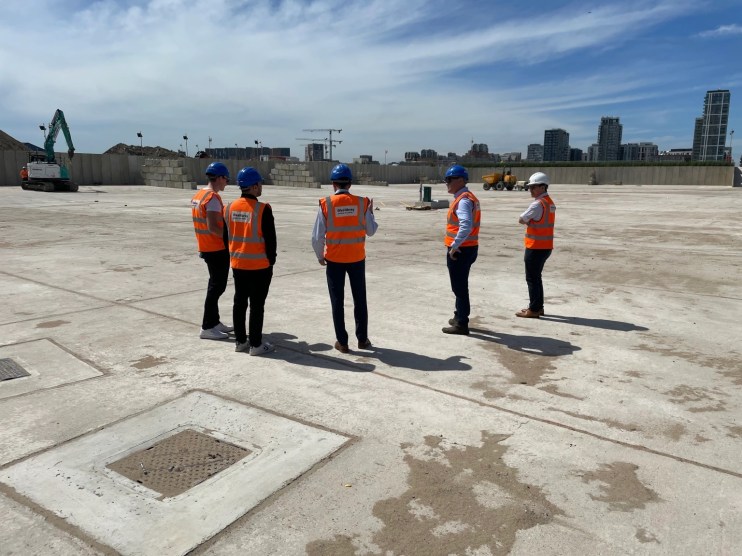Concrete plans: Will cement-free concrete ease emissions?

The UK’s ambitions to replenish its faltering infrastructure to secure its energy independence, meet its net zero goals, and cut regional inequality exist within a frustrating paradox.
Going green requires a vast ramp up of renewable and nuclear power projects, while ‘levelling up’ depends on housebuilding and new transport projects.
However, such plans also require vast concrete consumption – one of the most carbon-intensive products on the planet, undermining the environmental benefits of renewable projects and new infrastructure.
Concrete consists of water, aggregates such as rock, sand and gravel, and – crucially – cement to bind it all together.
The International Agency has calculated the cement is responsible for eight per cent of global CO2 emissions.
If it was a country, cement would be world’s third biggest polluter, behind only China and the US.
The Paris-based energy body urged the G7 earlier this year to reduce emissions from cement production, and has called for annual three per cent reductions worldwide until the end of the decade, to ensure countries meet the Paris Agreement.
Verner Viisainen, policy analyst at environmental think tank Green Alliance, told City A.M. that until a commercially low carbon alternative to concrete, demand had to be reduced.
He said: “Until we have a low carbon solution, reducing demand for concrete is key. That means renovating existing buildings, rather than building new, and when possible, using alternative materials, such as cross laminated timber.”
Cement-free concrete set for demand boost
However, Wagners – an Australian construction and materials specialist based in Queensland – believes its product could be the perfect solution.
It is home to Earth Friendly Concrete, a specialist supplier borne from its R&D division, that offers concrete made from fly ash and blast furnace slag.
This provides embodied carbon savings of 75-87 per cent, depending on the mix, while maintaining comparable resilience and consistency to concrete made from cement.
Michael Kemp, chief executive of Earth Friendly Concrete, told City A.M. its approach from the start has been to remove cement from the equation rather than merely cut back or reduce it in the mix.
He explained: “In simple terms, why make a mess and clean it up when you don’t have to make the mess in the first place?”
As it stands, the product has a price premium to conventional cement – around six per cent for pre-casts constructed prior to shipping and up to 25 per cent for general mixing.
However, Kemp is convinced this is chiefly a matter of production volume, and would be resolved as scale ramped up in line with demand.
He said: “There is a huge scaling opportunity for us, and our whole drive is to be bringing that in line with demand. What we are seeing is the demand for the product.”
At the moment, the company’s orders are typically in the hundreds of cubic meters, rather than the tens of thousands of giant competitors like CNBM and Holcim Group.

Nevertheless, it has established a firm UK footprint, with Earth Friendly Concrete enthused by the opportunities in a country it considers ahead of Western counterparts on the decarbonisation agenda.
City A.M. can reveal Earth Friendly Concrete has already been successfully trialled on several major rail and road infrastructure projects such as HS2’s phase one and the Transpennine Route Upgrade.
It has also been approved for use by the Environment Agency at a major sea defence scheme in Kent.
Other major partners for the company include Network Rail and British Land, while it also has an agreement with Capital Concrete in the London area.
Earth Friendly Concrete been operating from a plant in Silvertown, Newham, and has now completed its first concrete pour out of a new facility in Wembley – delivering 50 cubic metres of concrete for the HS2 project.
“This was a nice little milestone for us, that was our second plant activated,” Kemp said.
It is also eyeing smaller-scale construction alongside historic building projects, something that has been welcomed by the National Federation of Builders (NFB).
Richard Beresford, the NFB’s chief executive, said: “We welcome innovations such as cement free concrete, recycled aggregates and precast systems, which can be reused in future projects. After water, concrete is the world’s second most consumed product and therefore the NFB has been campaigning to ensure the innovations we achieve in the UK can translate to global change.”
The Government is supporting low carbon concrete options, unveiling its Industrial Decarbonisation Strategy last year which offers finance for the concrete sector to cut emissions.
The sector carried out demonstrations of a ‘zero carbon fuel mix’ for cement kilns in 2021, funded by the Business, Energy and Industrial Strategy department’s fuel switching programme.
The industry is targeting the delivery of net zero concrete and cement products across all supply chains by 2050.